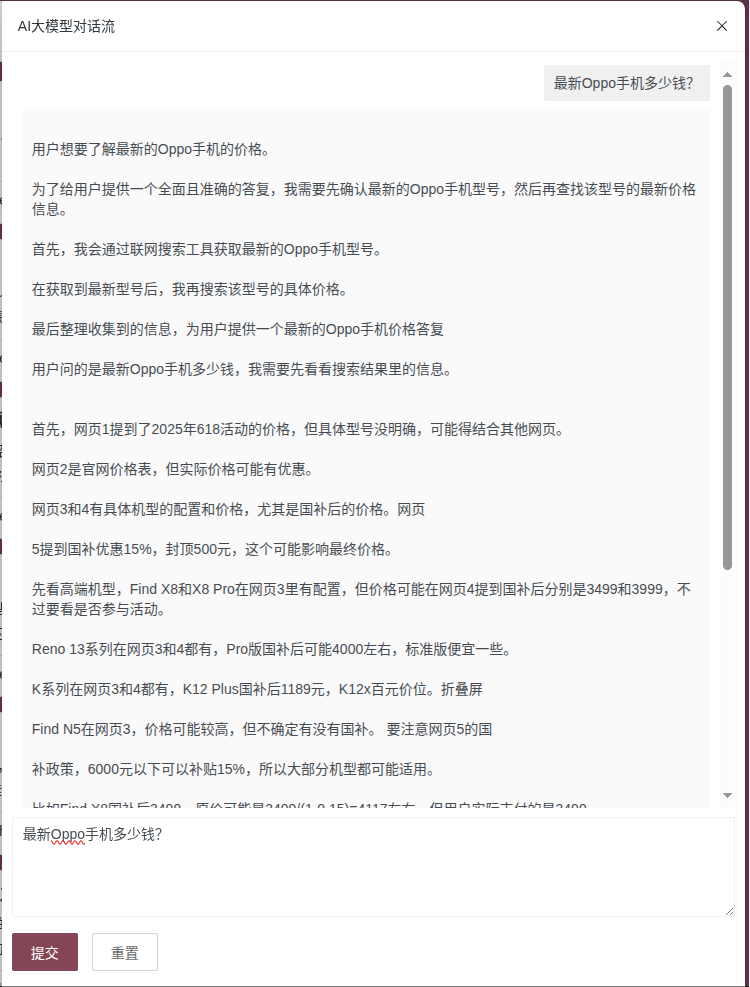这两年比较流行AI Agent,所以自用博客尝试了下接入,目前使用的是讯飞星火大模型的接口,token是有数量限制的,所以仅仅作为测试在本站展示,流式的对话切割插入的样式标签还不够完美,后续继续细化下,今天主要就来记录下实现的方法。
目前接入大模型接口接入有http和wss两种方式接入,由于flask使用socketIO只能使用一个进程和一个线程,所以我们摸索了下,还是使用http的方式接入,然后使用sse流式对话的方式,将后端拿到的流式对话通过sse往前推送,实现方式前我们需要使用到flask-sse这个包,然后还有redis,这两个我们先安装下。
pip install flask-sse redis我们的flask集成了工厂模式,然后配置文件是setting.py,然后需要增加配置
#大模型接口和SSE相关配置
API_PASSWD = "自己去平台获取"
BASE_URL = "https://spark-api-open.xf-yun.com/v2/chat/completions"
REDIS_URL = "redis://localhost:6379"然后我们专门写了一个蓝本作为sse接口的路由。
from apps.chat import chat#注册蓝本路由 def register_blueprint(app): app.register_blueprint(chat, url_prefix='/chat')
然后是chat目录下有__init__.py文件和view.py文件,内容分别如下:
__init__.py主要用于定义路由和导入请求的视图
from flask import Blueprint
chat = Blueprint('chat', __name__)
from . import view
view.py,前端以?channel=${channel}这样的参数是固定的,我们可以查看flask-sse的源码,他获取的channel参数名字就是这个,所以直接命名这个就无需改动。
#!/usr/bin/python3
#coding:utf-8
__author__ = 'yang.su'
from flask import request, current_app, jsonify
from flask_sse import sse
from apps import limiter
from . import chat
import bleach
import requests
import json
#创建对话流连接
@chat.route('/stream', methods=['GET'])
def stream():
return sse.stream()
#流式返回对话
@chat.route('/dialogue', methods=['GET', 'POST'])
def dialogue():
if request.method == "POST":
code, msg = [1, ""]
channel = request.args.get("channel")
try:
data = request.get_json()
prompt = data.get("prompt", None)
prompt = bleach.clean(prompt)
if prompt:
user_msg = "<div class='right'><p>{}</p></div>".format(prompt)
sse.publish({"message": user_msg}, type='message_event', channel=channel)
headers = {
'Authorization': "Bearer {}".format(current_app.config['API_PASSWD']),
'Content-Type': "application/json"
}
body = {
"model": "x1",
"user": "user_id",
"messages": [{"role": "user", "content": prompt}],
"stream": True,
"tools": [{"type": "web_search", "web_search": {"enable": True, "search_mode": "deep"}}]
}
response = requests.post(
url=current_app.config["BASE_URL"],
json=body,
headers=headers,
stream=True
)
paragraph = ""
describe = ""
is_paragraph = False
is_describe = False
for chunk in response.iter_lines():
if not chunk or b'[DONE]' in chunk:
continue
chunk_str = chunk.decode('utf-8').strip()
if chunk_str.startswith('data:'):
data_org = chunk_str[5:].strip()
try:
chunk_data = json.loads(data_org)
delta = chunk_data.get('choices', [{}])[0].get('delta', {})
# 处理思维链内容,包含段落html标签
reasoning = delta.get('reasoning_content', '')
if reasoning:
if not is_describe:
describe = reasoning
is_describe = True
else:
describe += reasoning
if any(punct in reasoning for punct in ['\n', '!', '?', '。', '!', '?']):
describe_html = "<div class='describe'><p>{}</p></div>".format(describe)
sse.publish({"message": describe_html}, type='message_event', channel=channel)
describe = ""
is_describe = False
# 处理最终回复内容,包含段落html标签
content = delta.get('content', '')
if content:
if not is_paragraph:
paragraph = content
is_paragraph = True
else:
paragraph += content
if any(punct in content for punct in ['\n', '!', '?', '。', '!', '?', '###']):
msg_html = "<div class='left'><p>{}</p></div>".format(paragraph)
sse.publish({"message": msg_html}, type='message_event', channel=channel)
paragraph = ""
is_paragraph = False
except Exception as e:
current_app.logger.error("JSON解析失败: {}, 原始数据: {}".format(e, data_org))
except Exception as e:
error_msg = "AI对话异常: {}".format(e)
current_app.logger.error(error_msg)
# 发送错误信息到前端
sse.publish({"message": "<div class='error'>{}</div>".format(error_msg)}, type='message_event', channel=channel)
msg = error_msg
return jsonify({
"code": code,
"msg": msg
})
return "Hello Flask-sse !"因为我们是使用频道的模式,没有使用广播的模式,所以使用session去主动设置了频道,是使用的uuid作为频道标识
在前台蓝本的钩子里主动设置了一个uuid作为频道标识
import uuid
#前台视图钩子,限制每秒三次点击
@article.before_request
@limiter.limit("2/second", error_message="Too many requests!")
def post_cache():
if not session.get("channel", None):
channel = str(uuid.uuid4())
session["channel"] = channel然后在前台公共模板的位置将这个值传递给js变量
<script>
var channelId = '{{ session.channel }}';
</script>最后就是js文件内容
$("#ask-ai").on("click", function(){
var screen_width = document.documentElement.clientWidth >= 768 ? '40vw' : '100vw';
layer.open({
type: 1,
title: "AI大模型对话流",
offset: 'r',
move: false,
anim: 'slideLeft', // 从右往左
area: [screen_width, '100%'],
shade: 0.1,
shadeClose: true,
scrollbar: false,
id: 'ID-demo-layer-direction-r',
content: $(".layui-chat")
});
var streamEvent = new EventSource('/chat/stream?channel='+channelId);
streamEvent.addEventListener("message_event", function(event){
data = JSON.parse(event.data);
document.getElementById('answer-box').innerHTML += data.message;
});
});
form.on('submit(send)', function(data){
$("#send").addClass("layui-btn-disabled");
$("#send").attr("disabled", true);
$.ajax({
url: '/chat/dialogue?channel='+channelId,
type: 'POST',
data: JSON.stringify(data.field),
contentType :"application/json",
dataType: 'json',
timeout: 300000,
error: function(){
layer.msg('请勿频繁提问,当前策略为每分钟只允许提问一次! ', {time: 1000, icon: 2});
},
complete: function(){
$("#send").removeClass("layui-btn-disabled");
$("#send").attr("disabled", false);
},
success: function(d){
if(d.code == 0){
$(".layui-textarea").val("");
layer.msg(d.msg, {icon: 1, time: 1000});
}
}
});
return false;
});上面的ask-ai按钮是用于弹出AI对话流的对话框,顺便在这个对话框里实例化并建立SSE连接,下面的提交是对话输入框,后端接口是通过这个对话框提交的数据去请求大模式接口,后端接口requests接口中有个stream的参数就是让对话以流式的方式通过sse不断往前端推送。
最后是效果图,本站验证的效果图

除了以上代码修改,还有nginx也需要进行修改,需要禁用缓冲区
proxy_buffering off;以上就是所有需要添加修改的地方,目前来看大模型接入很多接口都差不多,后面改用其他大模型接口只需要稍作修改。
内容版权声明:除非注明,否则皆为本站原创文章。
转载注明出处:https://sulao.cn/post/1048

评论列表